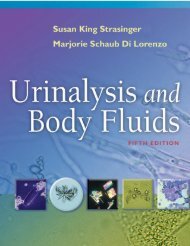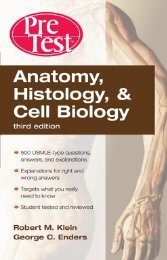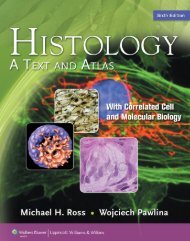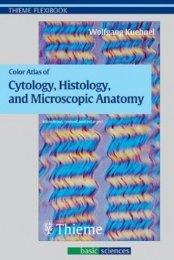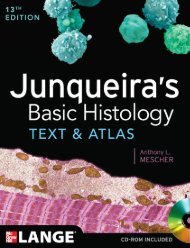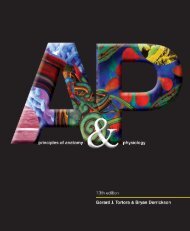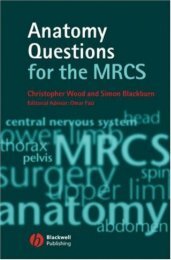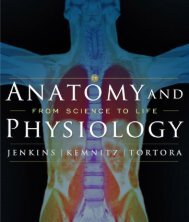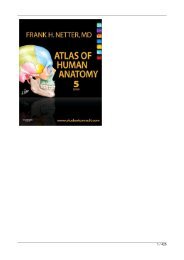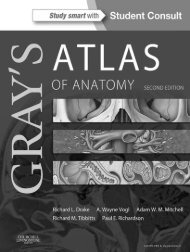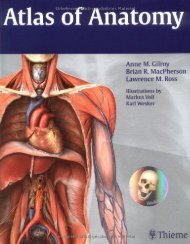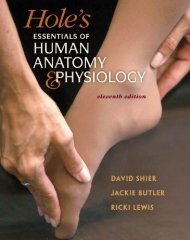theanatomyandphysiologylearningsystem4epdfdr-150930024720-lva1-app6891
You also want an ePaper? Increase the reach of your titles
YUMPU automatically turns print PDFs into web optimized ePapers that Google loves.
Chapter 2 Chemistry, Matter, and Life 25<br />
Table 2-2 Important Ions in the Body<br />
Ion Symbol Importance<br />
Calcium Ca 2+ Component of bones and teeth;<br />
necessary for blood clotting and<br />
muscle contraction<br />
Sodium Na + Principal cation in fluid outside cells;<br />
important in muscle contraction and<br />
nerve impulse conduction<br />
Potassium K + Principal cation in fluid inside cells;<br />
important in muscle contraction and<br />
nerve impulse conduction<br />
Hydrogen H + Important in acid-base balance<br />
Hydroxide OH − Important in acid-base balance<br />
Chloride Cl − Principal anion in fluid outside cells<br />
Bicarbonate HCO − 3<br />
Important in acid-base balance<br />
Ammonium NH + 4<br />
Important in acid-base balance;<br />
removes toxic ammonia from body<br />
Phosphate PO 3− 4<br />
Component of bones, teeth, and highenergy<br />
molecules; important in acidbase<br />
balance<br />
Iron Fe 2+ Important component of hemoglobin<br />
for oxygen transport<br />
charged ions. A negatively charged ion is called an anion<br />
(AN-eye-on). A chlorine atom has 17 protons and 17 electrons<br />
to make it electrically neutral. When it gains or picks up an<br />
electron, it still has 17 positively charged protons but now has<br />
18 negatively charged electrons to make it a negatively charged<br />
chloride ion (Cl − ) (see Figure 2-4).<br />
When an atom such as sodium loses or gives up an electron<br />
to another atom such as chlorine, two charged particles called<br />
ions are formed. One is a positively charged cation; the other<br />
is a negatively charged anion. Because of the opposite charges,<br />
the two ions are attracted to each other. The force of attraction<br />
between two oppositely charged ions is an ionic bond.<br />
Oppositely charged ions that are held together by ionic bonds<br />
are called ionic compounds. Sodium chloride (table salt),<br />
formed from sodium ions and chloride ions, is an example of<br />
an ionic compound.<br />
Covalent Bonds<br />
Covalent (koh-VAY-lent) bonds are formed when two atoms<br />
share a pair of electrons. Two hydrogen atoms, for example,<br />
can share their electrons to form a molecule of hydrogen gas.<br />
Because only one pair of electrons is shared, a single covalent<br />
bond is formed (Figure 2-5). Carbon has four electrons in its<br />
outer shell that it can share with other atoms to form covalent<br />
bonds. If it shares these electrons with four hydrogen atoms,<br />
then four single covalent bonds are formed and a molecule of<br />
methane gas results (Figure 2-6).<br />
1p<br />
Two hydrogen atoms each with one proton in the nucleus<br />
and one electron in the energy shell<br />
1p<br />
1p<br />
A molecule of hydrogen gas, H–H (H 2 )<br />
The two hydrogen atoms share an<br />
electron pair to form a single covalent bond<br />
Figure 2-5 Single covalent bond in hydrogen gas.<br />
1p<br />
<br />
<br />
11p <br />
12n o<br />
17p <br />
11p <br />
12n o<br />
18n o Sodium ion (Na ) Chloride ion (Cl )<br />
17p <br />
18n o<br />
Sodium atom (Na)<br />
Chlorine atom (Cl)<br />
Sodium chloride<br />
Figure 2-4 Formation of ionic bonds. An electron is transferred from the outer shell of the sodium<br />
atom to the outer shell of the chlorine atom. This transfer results in a positively charged sodium<br />
ion and a negatively charged chloride ion. The opposite charges attract to form the ionic bond<br />
of sodium chloride.




